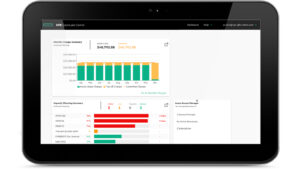Hewlett Packard Enterprise today unveiled an update of its GreenLake for File Storage offering that features a 4x increase in total capacity and up to 2x boost in system performance per rack unit. Depending on their situation, customers can use the improvements to accelerate AI workloads, slash costs, or reduce their footprint and power bills, HPE says.
GreenLake for File Storage is HPE’s unified big data storage platform that can store and serve data for file and block workloads at exabyte scale. At its core, it’s based on the Alletra Storage MP platform and uses the GreenLake for File Storage operating system, HPE says. It also uses partner VAST Data’s and its Disaggregated Shared Everything (DASE) architecture to serve as a NAS (network attached storage) solution.
At the hardware level, the GreenLake for File Storage encompasses a 2U compute enclosure, called CBox, while data is physically stored on 2U JBOF (just-a-bunch-of-flash) enclosures. Intra-enclosure connectivity is handled through 100GbE and redundant Aruba switches, while the connection back to the servers can be 100GbE, 40GbE, 25GbE, or 10GbE. The solution can be deployed in the cloud, on-prem, or on the edge.
HPE is now offering new all-NVMe JBOFs that can store up to 1.356PB in 1U of space, which is four times the density of the previous GreenLake for File Storage offering, according to David Yu, senior manager product marketing for HPE Storage. The CBox controller also now has double the processing power, he says.
HPE said it would deliver improvements in storage density, and it delivered. In fact, the improvements are even more impressive if one goes back two generation instead of just one, says Yu, who also took a shot as HPE’s competitors.
“With our latest high-density storage shelf, HPE GreenLake for File Storage has increased the capacity density of our high-end offering by 7x over what was released mid-2023,” Yu says in a blog. “Furthermore, and also as promised, HPE GreenLake for File Storage now delivers up to 2.3x the capacity density of Dell PowerScale and Pure Storage FlashBlade. It’s with improvements like these that HPE continues to lead the industry.”
AI is driving many of these new storage requirements, according to HPE. While the amount of data that’s involved in training and prompting large language models (LLMs) isn’t especially big, the size of the LLMs themselves, which can easily span into the billions of parameters, can pose a significant obstacle. HPE GreenLake for File Storage can connect to GPUs via InfiniBand, Nvidia GPUDirect, and RDMA networking technologies.
HPE hopes to remove capacity limitations to working with the latest generative AI technology while also shielding users from technical complexity, Yu says.
“Your data scientists and line-of-business application owners are no longer burdened by cumbersome, legacy file systems that require technical expertise and intricate setup processes just to run,” he writes in the blog. “A single global namespace enhances collaboration for faster time to discovery and innovation. And highly compensated subject-matter experts no longer need to expend valuable time and effort performing IT tasks but can instead focus on their key initiatives.”
Related Items:
HPE Fleshes Out GreenLake Hybrid Cloud Strategy
HPE Taps VAST Data For Fast File Storage on GreenLake
HPE Adds Lakehouse to GreenLake, Targets Databricks
The post HPE Cranks the Density on GreenLake NAS appeared first on Datanami.


0 Commentaires